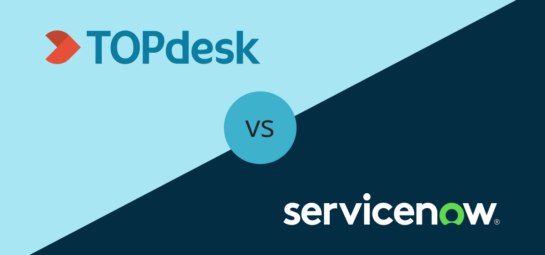26 IT service management terms – from ABC to XLA

The field of service management is no stranger to buzzwords. What do terms like ESM, SIAM and swarming mean? And how could they benefit your service delivery?
We collected a list of today’s most relevant trending IT service management terms, including a brief explanation and a suggestion for further reading, if you want to go more in-depth. This list contains new terms that were introduced during the past years, as well as older terms that regained popularity due to recent developments.
ABC
Stands for Attitude, Behavior, Culture. Refers to pretty much all people-related aspects of IT. (Perhaps it is telling that IT experts needed to come up with an acronym, rather than just say ‘people’?) Hopefully the beginning of a long-overdue acknowledgement that the people who deliver the service are crucial to service management success.
For more about culture, check out our blogs on service culture.
Agile
A mindset – not a framework! – that focuses on small, iterative experiments, rather than extensive, controlled projects. The 4 guiding principles of the Agile Manifesto are at the core of it all. Originally used for software development, its principals are now increasingly being adopted throughout the entire enterprise.
For more on how the agile mindset impacts service departments, check out our blogs on Agile Service Management.
AI
Artificial Intelligence. A catch-all term encompassing concepts like Machine Learning and NLP, but also used to denote Augmented Intelligence or smart automation. The current holy grail of all things service management. Knows a few practical applications in some situations (chatbots, automatic categorization, predictive analytics), but mainly a lot of promise for future use in the years to come.
Read more about the impact of AI on ITSM here.
AITSM
Nope, the first two letters don’t stand for Artificial Intelligence. Gartner introduced the concept of AITSM to cover all the efforts needed to successfully introduce AI and Automation in an organization. Some examples: collecting and optimizing data for Machine Learning functionality, setting up knowledge bases and designing conversations for chatbots, and training users on how to work with software that augments human intelligence.
AIOps
Yes, we’re back at AI again. AIOps means Artificial Intelligence for IT Operations, a term also coined by Gartner. What it could mean in practice? Using big data and Machine Learning to automate tasks, identify strange usage patterns, recognize attacks and predict disturbances.
More on AIOps.
Bi-modal IT
The practice of combining traditional working processes with agile ones. Using traditional methods such as ITIL to control predictable processes (mode 1), while applying an agile approach to unfamiliar, less predictable projects (mode 2). Again, a term coined by Gartner.
COBIT 2019
COBIT stands for Control Objectives for Information Technology. A framework for security, risk management and information governance, originally designed to help structure financial audits, which saw an update in 2019. The 2019 update aims to make COBIT more applicable in an environment where multiple other frameworks (such as ITIL and SIAM) are already in use.
More on COBIT 2019.
Customer Journey Mapping
A popular method for gaining insight into the customer experience of your services. You map all touchpoints of your service, from self-service portal and knowledge base to email and phone conversation, and the customer experience across the entire customer journey. This helps you identify and prioritize opportunities for improvement.
More on Customer Journey Mapping.
CX
The focus on helping your customers the best you can. CX is becoming the goal for more and more service organizations. One of the drivers is heightened expectations customers have due to consumer technology – if you can order a private laptop and have it the next day, why should requesting a business laptop take 3 weeks? One way to measure CX is XLAs.
DevOps
The practice where Development and Operations teams work together on the entire release chain, from concepting and design to supporting the product. Originated as an answer to agile Development teams starting to release new functionalities more often, and Operations being less in the know about those functionalities and how to support them.
More on DevOps.
Digital transformation
Transforming the way your customers are serviced from the ground up, using modern digital technology. A popular topic since a few years, but as a project a very difficult one to pull off, since its scope is very broad and it requires an organizational mind shift. Done right, digital transformation enables customers to help themselves, resulting in faster delivery, a great CX, and potentially huge cost savings.
For more on digital transformation and its challenges, read this McKinsey article.
EX
Employee Experience. Basically customer experience (CX), but for employees. Also known as Workforce Enablement. Enabling employees in your organization to do their best work, efficiently. Requires a joint effort from all supporting teams (ESM) and suppliers (SIAM).
More on Employee Experience.
ESM
Enterprise Service Management. There’s not a single accepted definition, but it’s generally meant to indicate the idea of focusing on delivering great services, regardless of which teams or departments deliver the service. Requires close collaboration with your customers (CX/EX) between various teams (ESM), and with your suppliers (SIAM).
More on Enterprise Service Management.
IoT
Internet of Things. Not a new term, but increasingly relevant due to increased adoption of smart technology. IoT-applications such as smart thermostats and smart lighting, and workplace occupancy use IT technology for facility purposes. IoT applications provide usage data about your office building, enabling you to increase efficiency of usage and save money. Requires close collaboration between IT and Facility departments.
More on Internet of Things.
ITIL 4
The new version of ITIL, of which the first part (ITIL Foundation) was introduced in February 2019. The main differences with ITIL v3 are a stronger focus on people and value, a more pragmatic (dare I say agile?) approach to best practices, and the introduction of guiding principles.
More on ITIL 4.
KCS
Knowledge Centered Service – formerly known as Knowledge Centered Support. An agile way of approaching knowledge management. KCS entails a demand-driven, iterative process that makes knowledge registration and sharing an integral part of a service team.
More on KCS.
Lean
A philosophy focused on cutting waste in your daily work, to focus on what truly matters. Lean is not a new term, but has gained renewed relevance in service management due to the rise of agile ways of working – and due to the introduction of ITIL 4, which relies heavily on the lean mindset and terminology.
More on Lean Service Management.
Omnichannel support
Offering consistent customer experience over various communications channels. Sometimes confused with Multichannel support, which refers to offering your customers more than one communication channel – which all service desks are doing anyway. Customer Journey Mapping is a popular way of checking the success of your Omnichannel strategy.
More on Omnichannel support.
Peer-to-peer support
Co-workers helping each other out with issues that otherwise would have to be solved by supporting departments. Can be actively supported or facilitated by introducing power users within the organization, and publishing a knowledge base these power users can consult.
More on peer-to-peer support and power users.
RPA
Robotic Process Automation. Programming a robot to process a series of simple, predictable tasks. Sounds like another form of Artificial Intelligence, but that not’s necessarily the case. RPA is a form of advanced automation that sometimes makes use of Artificial Intelligence to get the job done.
Read more about RPA and the difference with AI in this blog on Medium.
Service automation
Having machines do work that was previously done by people, freeing up their time to work on other, more challenging tasks. Not a new term. Owes its renewed popularity to the promise of AI-powered automation. One of the main challenges with automation for service departments is increasing efficiency without negatively impacting your customer experience.
More on service automation.
Service culture
A shared mindset at an organization that is focused on helping your customers, with CX as one of the most important goals. Becoming more relevant in the slipstream of an increased world-wide interest in company culture as the basis for organizational success.
More on service culture.
SIAM
Service Integration And Management. An approach to service management, focusing on close collaboration with all your service parties, both internal and external. Introduced to help organizations maintain quality of their service delivery by managing their network of suppliers.
Swarming
An agile form of support that relies heavily on interpersonal collaboration and less on following strict processes. Developed as an alternative to the 3-tier support model where calls are escalated and passed on from one team to the other.
More on swarming.
VeriSM
VeriSM is an approach to service management that helps you choose which frameworks and methods work best for your organization. Stands for Value-driven, Evolving, Responsive, Integrated Service Management. One its key messages: all teams in an organization should work together towards a single goal, but that does not mean they should all use the same tools or follow the same processes.
More on VeriSM.
XLA
eXperience Level Agreement. A method for defining and measuring customer satisfaction. XLAs were introduced to supplement SLAs, since reports on response times and call duration don’t always provide a complete view of customer satisfaction. Used in collaboration with suppliers or customers.
More on XLAs and SLAs.
Download this free ITSM Word search

Staying on top of your industry trends and terminology can be pretty intense. Relaxing regularly is very important.
We’ve created a Word search for you containing all ITSM terms mentioned above. So get a cup of coffee, print the Word search and sit down for this puzzle. Can you find all ITSM terms? Good luck!
Inspire others, share this blog





